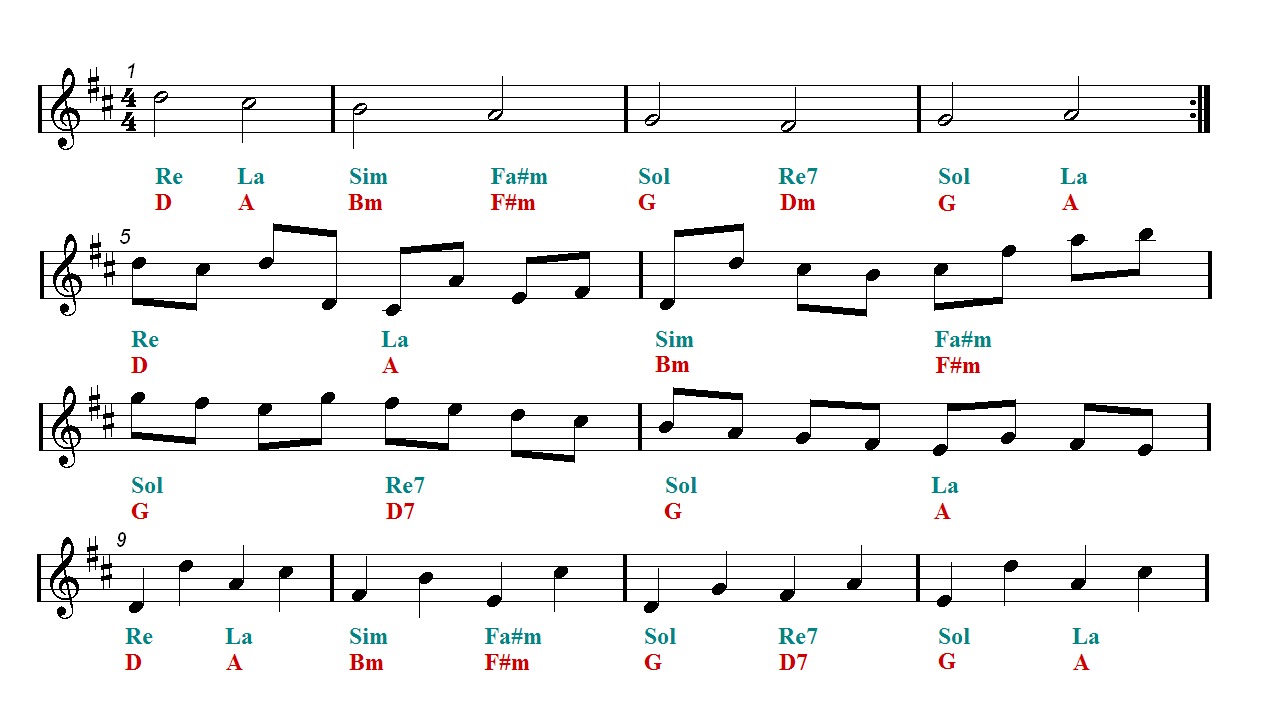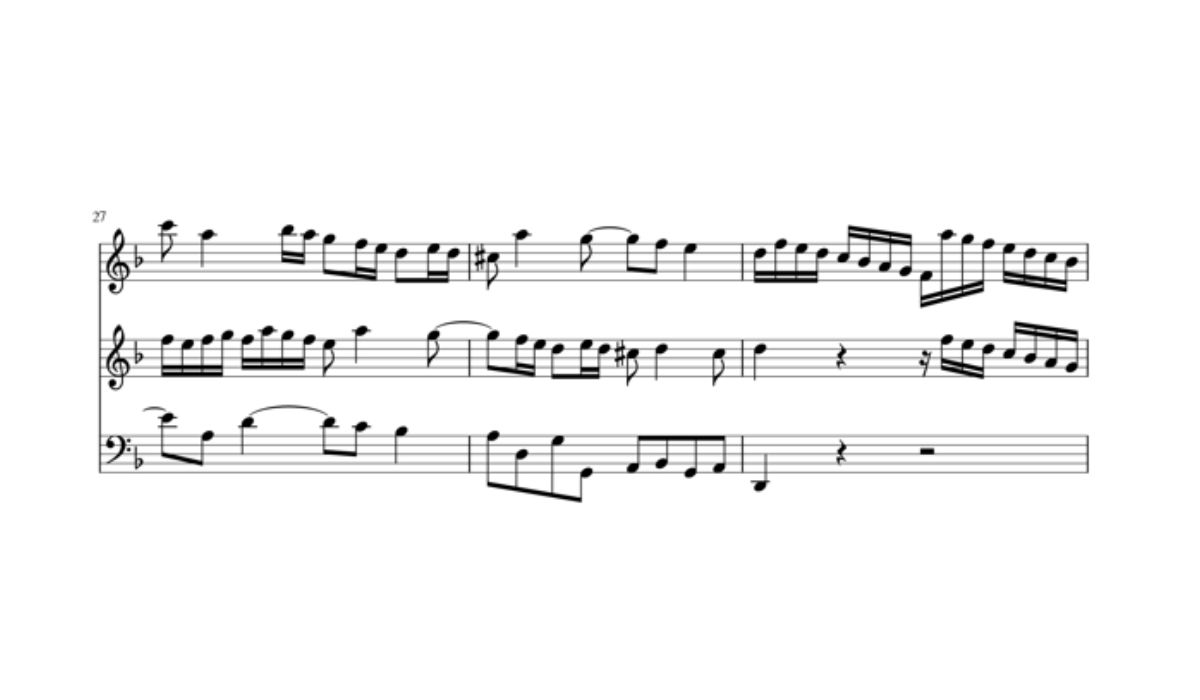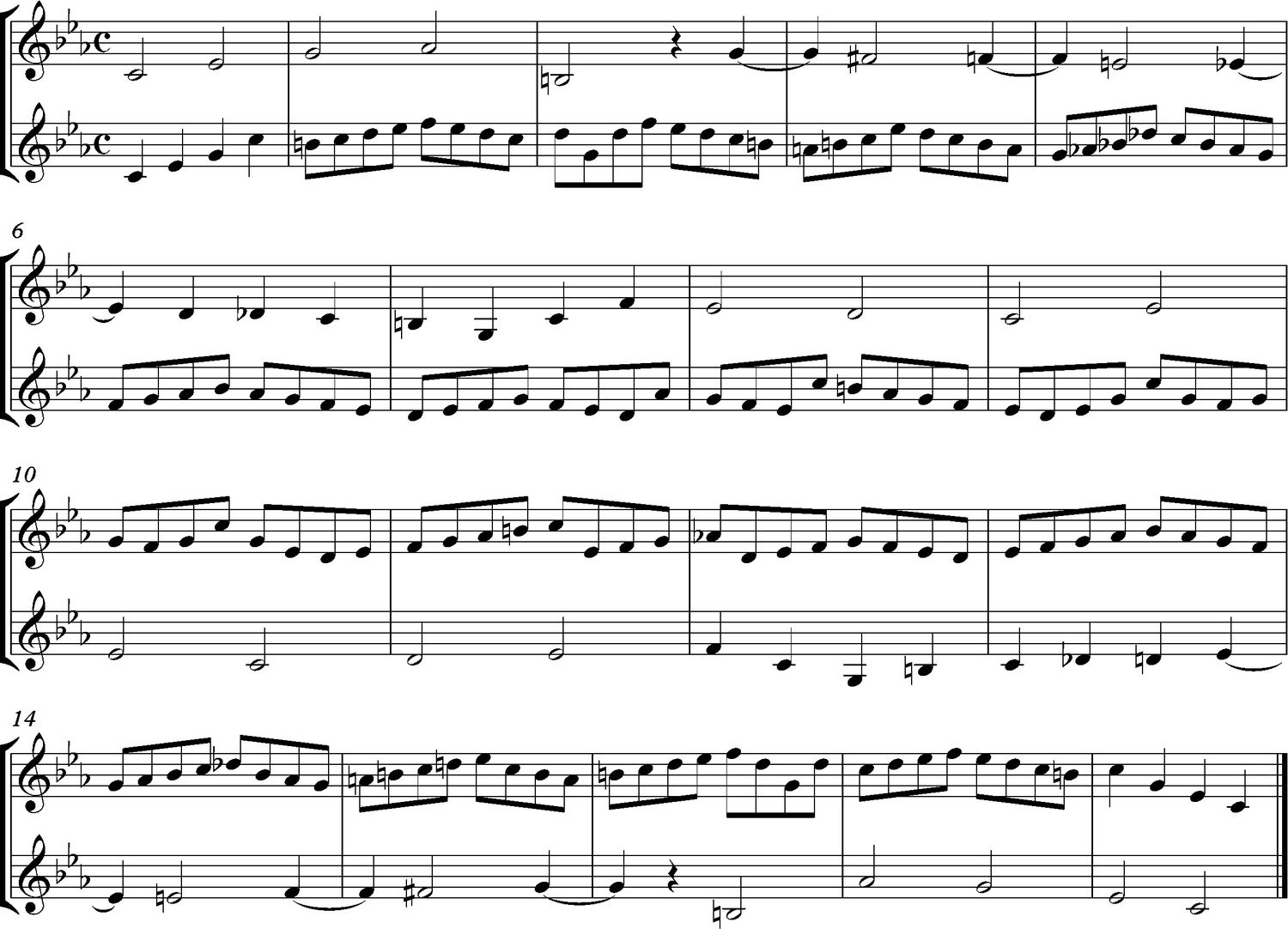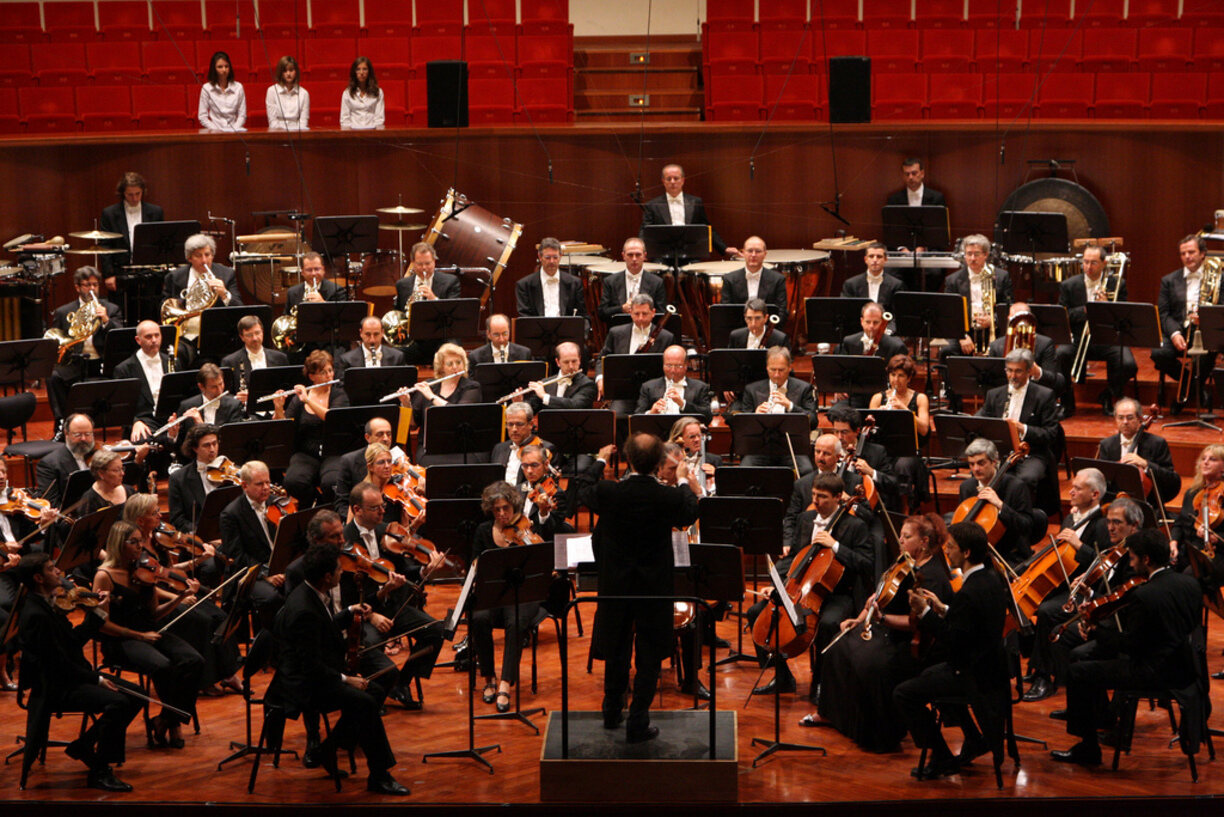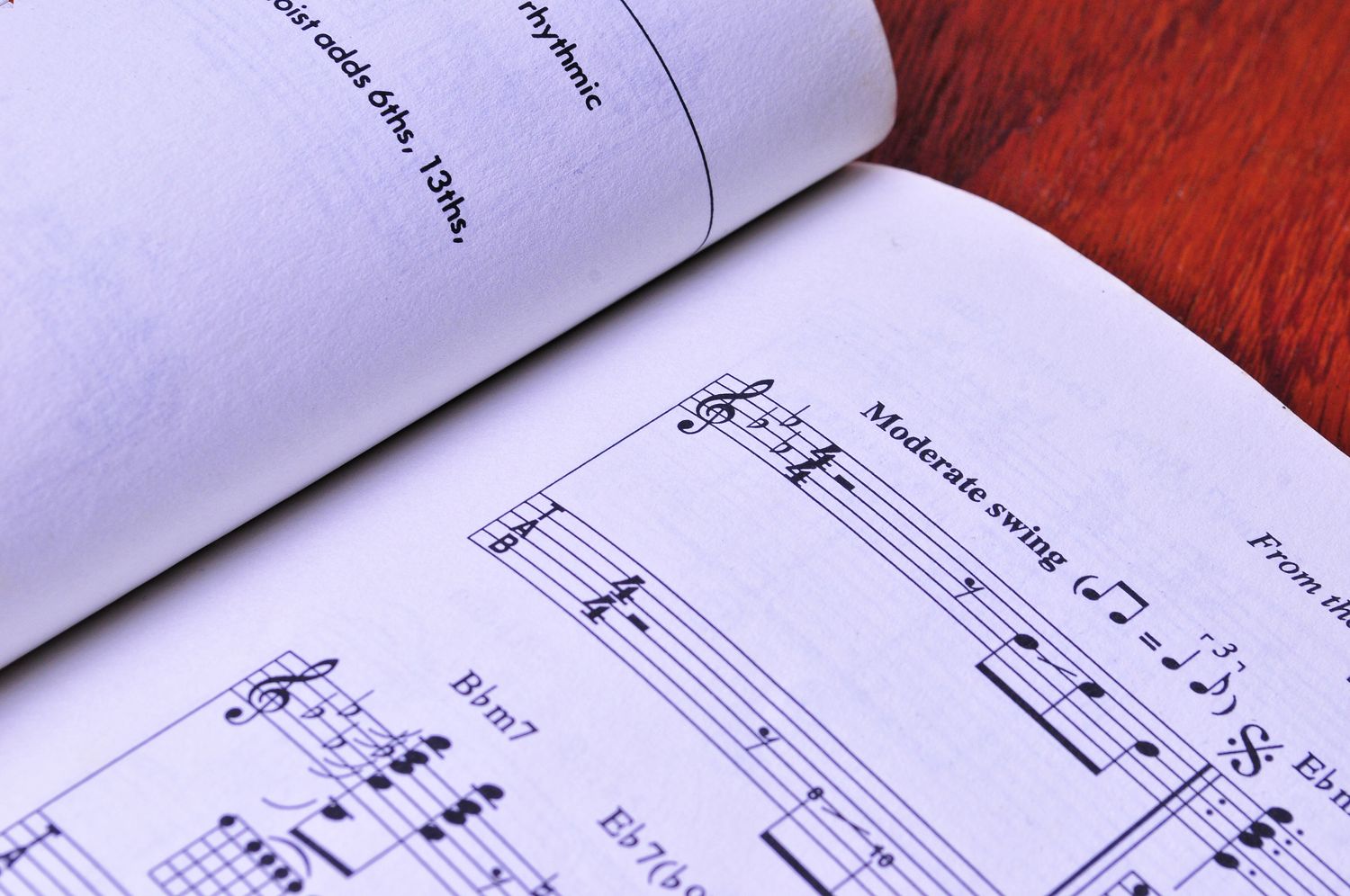Home>Production & Technology>Music Theory>What Things To Know For Advanced Music Theory


Music Theory
What Things To Know For Advanced Music Theory
Modified: February 11, 2024
Discover the essential elements of advanced music theory. Enhance your understanding of chords, scales, and harmonic progressions for a deeper musical experience.
(Many of the links in this article redirect to a specific reviewed product. Your purchase of these products through affiliate links helps to generate commission for AudioLover.com, at no extra cost. Learn more)
Table of Contents
- Introduction
- Understanding Modes
- Advanced Chord Progressions
- Extended Harmonies
- Modal Interchange
- Chromaticism in Composition
- Advanced Scales and Arpeggios
- Complex Rhythmic Concepts
- Polytonality and Polyrhythms
- Analysis of Advanced Music Forms
- Counterpoint Techniques
- Orchestration and Arrangement Techniques
- Advanced Music Notation
- Composition and Songwriting in Advanced Music Theory
- Conclusion
Introduction
Welcome to the world of advanced music theory! As a musician, understanding the nuances and intricacies of music theory can take your skills to new heights. While the basics of music theory provide a foundation, delving into advanced concepts opens up a world of possibilities for composition, improvisation, and musical expression.
In this article, we will explore various aspects of advanced music theory, from understanding modes and chord progressions to exploring complex scales, rhythms, and musical forms. Whether you’re a seasoned musician looking to expand your knowledge or a budding composer eager to dive deeper into the realm of music theory, this article will provide you with valuable insights and techniques.
One of the key areas we will explore in advanced music theory is modes. Modes are alternative scales that can be derived from the major scale, each with its own unique characteristics and mood. Understanding modes allows you to add depth and color to your compositions, giving you a vast array of musical options to explore.
Another essential aspect of advanced music theory is chord progressions. While basic chord progressions are commonly used in many songs, delving into advanced chord progressions can add complexity and sophistication to your compositions. We will explore concepts like extended harmonies and modal interchange, which can elevate your chord progressions to new heights.
Furthermore, we will dive into the realm of chromaticism. Chromaticism involves the use of notes outside the key, creating tension and adding a unique flavor to your compositions. We will discuss how to effectively use chromaticism in composition, opening up a world of possibilities for creating rich, dynamic, and innovative musical pieces.
As we delve into advanced music theory, we will also explore complex rhythmic concepts, such as polyrhythms and irregular meters. These rhythmic techniques can add excitement, complexity, and interest to your compositions, pushing the boundaries of what is possible in music.
The art of counterpoint will also be a focal point in this article. Counterpoint involves the interplay of different melodic lines, creating a rich and textured musical landscape. We will explore various counterpoint techniques, allowing you to craft captivating melodies and harmonies in your compositions.
Additionally, we will touch upon orchestration and arrangement techniques. Understanding how different instruments and voices can complement each other in an ensemble setting will enable you to create powerful and evocative musical arrangements.
Understanding and utilizing advanced music notation is also crucial for communicating your musical ideas effectively. We will discuss various notation techniques, including unconventional notation symbols and techniques used in contemporary music.
Finally, we will explore composition and songwriting in the context of advanced music theory. We will discuss how to incorporate all the concepts and techniques covered in this article to create cohesive and compelling musical pieces.
By the end of this article, you will have a comprehensive understanding of advanced music theory and a wealth of techniques to enhance your musical creations. So, let’s embark on this musical journey and explore the depths of advanced music theory!
Understanding Modes
Modes are alternative scales that can be derived from the major scale. Each mode has a distinct set of intervals and a unique sound, allowing you to create different moods and flavors in your compositions.
The most common mode is the Ionian mode, which is essentially the major scale. It has a bright and uplifting quality and is widely used in pop, rock, and classical music. The Dorian mode, on the other hand, is a minor mode with a slightly melancholic and jazzy feel. It can add a touch of sophistication and intrigue to your compositions.
The Phrygian mode has a distinct Spanish, flamenco-like quality. It has a slightly exotic sound due to its flattened second scale degree. This mode can add intensity and drama to your compositions, making it suitable for genres like metal and progressive rock.
The Lydian mode is known for its dreamy and ethereal sound. It features a raised fourth scale degree, giving it a unique and otherworldly quality. This mode can add a sense of mystery and wonder to your compositions, making it popular in ambient and film music.
The Mixolydian mode has a bluesy and rock-oriented sound. It features a flattened seventh scale degree, giving it a distinctive and edgy quality. This mode is frequently used in blues, rock, and jazz music to create a groovy and laid-back feel.
The Aeolian mode, also known as the natural minor scale, is a minor mode that has a haunting and emotional quality. It is commonly used in various genres, including classical, metal, and pop, to evoke a sense of darkness or melancholy.
The Locrian mode is the darkest and most dissonant mode. It has a diminished fifth scale degree, giving it a tense and unstable sound. This mode is rarely used in its pure form but can add an element of tension and suspense when used selectively.
Understanding modes allows you to broaden your harmonic and melodic options. By exploring different modes and incorporating them into your compositions, you can create unique and captivating musical pieces. Experiment with different modes and listen to how they sound in different musical contexts to fully grasp their potential.
It is worth noting that modes can be applied not only to melodies but also to chord progressions, allowing you to further explore harmonic possibilities. For example, using a Dorian mode chord progression can add a distinct flavor to your music, even if the melody is based on the major scale.
Ultimately, learning and understanding modes opens up a world of creativity and expression. It allows you to break free from the confines of traditional major and minor scales and explore a vast array of musical possibilities. So, embrace the power of modes and let them inspire and guide your musical journey.
Advanced Chord Progressions
While basic chord progressions serve as the foundation of many songs, delving into advanced chord progressions can add complexity, depth, and sophistication to your compositions.
One of the key concepts in advancing chord progressions is the use of extended harmonies. Traditional chords are typically built using triads, which consist of three notes: the root, the third, and the fifth. However, in advanced chord progressions, you can incorporate additional notes to create richer and more complex harmonies.
One of the most common extended harmonies is the seventh chord. By adding the seventh note of the scale to a triad, you create a chord that has a stronger sense of tension and resolution. Seventh chords come in various forms, including major seventh, dominant seventh, minor seventh, and half-diminished seventh. Each type of seventh chord has a distinct sound and can be used to create different moods and emotional effects in your compositions.
Another advanced chord progression technique is modal interchange. Modal interchange refers to borrowing chords from parallel modes or scales. For example, if you are in the key of C major, you can borrow chords from the parallel C minor scale or other related scales. This allows you to introduce unexpected and unique chord progressions that add color and variety to your compositions.
Furthermore, advanced chord progressions often involve non-diatonic chords. Non-diatonic chords are chords that do not naturally belong to a particular key or scale. By incorporating non-diatonic chords strategically, you can create interesting and captivating harmonic progressions that push the boundaries of traditional tonality.
Using secondary dominant chords is another technique in advanced chord progressions. A secondary dominant is a dominant chord that is not the V chord of the key. By introducing secondary dominant chords, you can create moments of tension and resolution that add excitement and interest to your compositions.
Additionally, exploring chord substitutions can take your chord progressions to the next level. Chord substitutions involve replacing a chord with another chord that shares similar harmonic qualities. This technique allows you to add unexpected twists and turns to your progressions, creating surprises and capturing the listener’s attention.
Ultimately, advanced chord progressions offer a vast array of possibilities for expressing emotion, creating tension and release, and crafting memorable musical moments. By experimenting with extended harmonies, modal interchange, non-diatonic chords, secondary dominants, and chord substitutions, you can develop unique and captivating chord progressions that elevate your compositions to new heights.
It is essential to remember that while advanced chord progressions can add complexity, they should still serve the overall musical context and convey the intended emotion or message. Use them judiciously and with purpose, and always trust your musical intuition to guide you in creating captivating and emotionally compelling chord progressions.
Extended Harmonies
In advanced music theory, one of the key techniques to enhance chord progressions is the use of extended harmonies. Extended harmonies involve adding additional notes to traditional triads, creating richer and more complex chords.
A common form of extended harmony is the seventh chord. By adding the seventh note of the scale to a triad, you create a chord that has a stronger sense of tension and resolution. Seventh chords come in various forms, including major seventh, dominant seventh, minor seventh, and half-diminished seventh. Each type of seventh chord has a distinct sound and can be used to create different moods and emotional effects in your compositions.
Let’s explore the different types of seventh chords:
- The major seventh chord consists of the root, major third, perfect fifth, and major seventh. It has a smooth and sophisticated sound, often associated with jazz and classical music. Major seventh chords can add a sense of warmth and beauty to your chord progressions.
- The dominant seventh chord comprises the root, major third, perfect fifth, and minor seventh. It has a strong and unresolved sound, often used to create tension and anticipation. Dominant seventh chords are frequently employed in blues, jazz, and rock music to add a gritty and bluesy quality to the progressions.
- The minor seventh chord is built with the root, minor third, perfect fifth, and minor seventh. It has a melancholic and mellow sound, commonly found in jazz, soul, and R&B music. Minor seventh chords can add a touch of sophistication and depth to your chord progressions.
- The half-diminished seventh chord consists of the root, minor third, diminished fifth, and minor seventh. It has a dark and ambiguous sound, often used to create tension and suspense. Half-diminished seventh chords are commonly found in jazz and classical music, adding a sense of complexity and intrigue to the progressions.
Extended harmonies can also go beyond seventh chords. By adding even more notes to a chord, you can create even richer and more colorful harmonies. Ninth chords, eleventh chords, and thirteenth chords are just a few examples of further extended harmonies.
The ninth chord adds the ninth note of the scale to a seventh chord, creating a rich and jazzy sound. Eleventh chords incorporate the eleventh note along with the seventh and ninth, providing a complex and sophisticated character. Thirteenth chords involve the addition of the thirteenth note, resulting in a lush and expansive sound.
When using extended harmonies, it is crucial to consider their function within the context of the music. They can be used to create tension, resolution, and emotional depth. By strategically incorporating extended harmonies into your chord progressions, you can add complexity, interest, and variety to your compositions.
Experiment with different types of extended harmonies and listen to how they interact with the melody and other instruments or voices in your arrangements. The careful use of extended harmonies can elevate your music to new heights and captivate your listeners.
Remember, while extended harmonies offer a wide range of possibilities, it is essential to use them in a tasteful and purposeful manner. Balance their complexity with simplicity, and ensure they serve the overall musical context and emotions you want to convey. With practice and exploration, you will develop a keen sense of when and how to employ extended harmonies to create truly exceptional chord progressions.
Modal Interchange
In advanced music theory, modal interchange is a technique that involves borrowing chords from parallel modes or scales. It provides a creative way to add color, variety, and unexpected twists to your chord progressions.
When we talk about modal interchange, we are referring to using chords that are not normally found in the current key or scale but are borrowed from a related mode. For example, if you are in the key of C major, you can borrow chords from the parallel C minor scale or other related scales like Dorian, Phrygian, or Mixolydian.
This technique allows you to introduce chords that have a unique harmonic flavor and can evoke different moods and emotions. By incorporating borrowed chords, you can add complexity and depth to your compositions.
For instance, if you are in the key of C major and want to introduce a touch of melancholy or darkness, you can borrow a chord from the C minor scale. The borrowed chord could be the tonic chord (Cm), creating a temporary shift in tonality. This creates a poignant moment and adds a new dimension to your music.
Modal interchange can also be used to create harmonic tension and resolution. By borrowing chords from a mode with different harmonic characteristics, you can introduce unexpected and compelling progressions that captivate the listener’s attention.
For example, consider a chord progression in the key of C major: C – G – Am – F. To add tension and variation, you can borrow chords from the parallel C minor scale. By replacing the Am chord with an A diminished or an A minor chord, you create a unique and distinct sound. The borrowed chord introduces a subtle dissonance, creating tension that resolves when returning to the F chord.
Modal interchange not only applies to chord progressions but can also be used to spice up melodies. By incorporating notes from a parallel mode, you can add interesting twists and turns to your melodies, making them more captivating.
Exploring modal interchange opens up a world of creative possibilities. It allows you to break away from the constraints of traditional major and minor scales and introduces tonal ambiguity, unexpected harmonies, and refreshing melodic ideas.
Experiment with different borrowed chords and listen to how they interact with the rest of your composition. Pay attention to how they affect the mood, tension, and overall atmosphere of the music. Modal interchange is a powerful tool in your musical arsenal that can elevate your compositions to new heights.
However, it’s crucial to use modal interchange with care and intention. Don’t overuse borrowed chords to the point where they become distracting or disjointed. The goal is to enhance the overall musical narrative and evoke the desired emotions.
By incorporating modal interchange into your compositions, you can add depth, complexity, and harmonic interest. Embrace the art of borrowing chords from parallel modes, and let the creative possibilities of modal interchange expand your musical horizons.
Chromaticism in Composition
Chromaticism is a compositional technique that involves the use of notes outside of the key or scale, adding tension, color, and richness to your compositions. It is a powerful tool that can elevate your music to new levels of expressiveness and complexity.
When we talk about chromaticism, we are referring to the inclusion of chromatic tones, which are notes that do not belong to the current key or scale. These notes often create a sense of dissonance or tension, contrasting with the more stable notes of the key.
Chromaticism can be employed in various ways in composition. One common technique is the use of chromatic passing tones, which are brief, non-diatonic notes between two diatonic tones. These passing tones add color and melodic interest to your compositions, creating a sense of forward motion or embellishing a melody.
Another technique is the inclusion of chromatic harmonies. By using chords that contain chromatic alterations, such as augmented or diminished chords, you can enhance the sense of tension and create a unique harmonic character. Chromatically altered chords can provide unexpected twists and evocative sounds, adding depth and emotional complexity to your music.
Using chromatic lower and upper neighbor tones is another way to incorporate chromaticism. Lower neighbor tones involve temporarily descending chromatically below a target note, while upper neighbor tones ascend chromatically from a target note. These chromatic neighbor tones can be used to embellish melodies, add tension, or create engaging harmonic progressions.
Chromaticism can also be used to modulate or transition between different keys. By introducing chromatic chords or chromatic pivot tones, you can smoothly move from one tonal center to another, adding a sense of surprise and interest to your compositions.
When incorporating chromaticism, it’s important to consider the intended effect. Chromatic tones can evoke a range of emotions, from melancholy and tension to excitement and intrigue. Experiment with different chromatic notes, chords, and progressions to find the desired ambiance for a particular section of your composition.
However, it’s crucial to use chromaticism judiciously and with purpose. Too much chromaticism can result in a disorganized or chaotic sound. Balancing the use of chromatic tones with diatonic elements can provide a pleasing contrast and maintain a sense of stability.
Listening to composers who have effectively employed chromaticism, such as Richard Wagner, Claude Debussy, and Igor Stravinsky, can provide inspiration and insight into its application. Study their compositions and analyze how they incorporate chromaticism to create unique and captivating musical experiences.
Chromaticism is a powerful tool that can bring depth, tension, and emotional richness to your compositions. Embrace its potential and experiment with different chromatic techniques to add complexity and intrigue to your music, unveiling unique and captivating sonic landscapes.
Advanced Scales and Arpeggios
In advanced music theory, exploring new scales and arpeggios can expand your musical palette and provide you with unique melodic and harmonic possibilities. These advanced scales and arpeggios offer a deeper understanding of tonality and can add complexity and interest to your compositions and improvisations.
One example of an advanced scale is the diminished scale. The diminished scale is characterized by alternating half and whole steps, creating a symmetrical and distinctive sound. It is commonly used in jazz, fusion, and classical music and is particularly effective in creating tension and adding dissonance to your musical phrases.
Another advanced scale is the whole-tone scale. The whole-tone scale is formed by using only whole steps, resulting in a dreamy and ethereal sound. It is often associated with impressionist music and can be used to create a sense of mystery and ambiguity in your compositions.
The pentatonic scale, while widely known and used, can also be explored in more advanced ways. By incorporating additional tones, such as the blues note or additional passing tones, you can create variations of the pentatonic scale that bring new flavors and nuances to your melodies and improvisations.
Arpeggios are another essential component of advanced music theory. An arpeggio is a broken chord, played one note at a time. In addition to major and minor arpeggios, you can explore more complex and extended arpeggios, such as dominant seventh, diminished, or augmented arpeggios.
Practicing advanced scales and arpeggios helps develop finger dexterity, musical phrasing, and improvisational skills. By incorporating these advanced patterns into your playing, you can add intricate and sophisticated melodic lines to your compositions and arrangements.
It’s important to note that simply playing advanced scales and arpeggios mechanically is not enough. Understanding their harmonic function and how they fit within a musical context is crucial. Experiment with these scales and arpeggios in different keys, progressions, and rhythmic patterns to fully explore their sonic possibilities.
Listening to and analyzing the works of composers and musicians who utilize advanced scales and arpeggios, such as John Coltrane, Olivier Messiaen, or Frank Zappa, can further deepen your understanding and inspire new creative approaches.
Remember, the goal is not to use advanced scales and arpeggios for the sake of complexity alone but to employ them tastefully to enhance your musical expression. Use them to add depth, tension, and uniqueness to your compositions and improvisations, allowing your creativity to soar to new heights.
Complex Rhythmic Concepts
Rhythm is the driving force behind music, and delving into complex rhythmic concepts can significantly enhance the depth and intricacy of your compositions. Exploring advanced rhythmic techniques allows you to create captivating and dynamic musical experiences.
One technique to explore in complex rhythm is polyrhythm. Polyrhythm involves the simultaneous use of two or more different rhythmic patterns or meters. By layering contrasting rhythms, you can create intricate and rhythmic tension in your compositions. Polyrhythms can be achieved through the use of different time signatures, subdivisions, or rhythmic groupings. They add complexity and interest to your music, demanding the listener’s attention.
Additionally, irregular meters provide another advanced rhythmic concept. Instead of sticking to traditional time signatures like 4/4 or 3/4, irregular meters introduce asymmetrical or changing rhythmic patterns. This rhythmic freedom can create a sense of unpredictability and tension. Experimenting with irregular meters allows you to break away from conventional rhythmic patterns and discover new rhythmic possibilities.
Syncopation is another technique that adds complexity to rhythm. Syncopation involves accenting the off-beats or unexpected weak beats, creating a rhythmic tension. By deliberately shifting accents and emphasizing unexpected rhythmic placements, you can create a sense of groove, energy, and anticipation in your compositions.
Exploring intricate and intricate rhythmic patterns, such as polymeters and polyrhythms, can take your compositions to the next level. Polymeters involve the simultaneous use of different time signatures, where each instrument or part plays in a distinct meter. This technique creates a fascinating and complex rhythmic texture, adding depth and sophistication to your music.
Furthermore, metric modulation is a useful technique in complex rhythm. Metric modulation involves changing the rhythmic pulse or subdivision, resulting in a shift in the perception of tempo. This concept allows you to seamlessly transition between different rhythmic feels and tempos, creating exciting and unexpected rhythmic transformations in your compositions.
When working with complex rhythmic concepts, it’s important to consider the overall musical context and balance the complexity with a sense of musicality. Avoid overwhelming the listener with excessive rhythmic complexity that detracts from the musical essence. Experiment with different rhythmic ideas and listen carefully to how they interact with the other elements in your composition.
Listening to and studying music that incorporates complex rhythmic concepts, such as jazz, contemporary classical music, or world music, can inspire new rhythmic ideas and expand your rhythmic vocabulary. Analyzing the works of rhythmically innovative composers like Igor Stravinsky, Steve Reich, or Tony Williams can provide insights into their approaches and help fuel your own rhythmic explorations.
Remember, incorporating complex rhythmic concepts should serve your musical vision and the emotional message you want to convey. Let the rhythm be a driving force in your compositions, pushing the boundaries of convention and infusing your music with complexity and excitement.
Polytonality and Polyrhythms
Polytonality and polyrhythms are advanced musical concepts that can bring a sense of complexity, tension, and interest to your compositions. By exploring these techniques, you can create captivating and intricate musical experiences.
Polytonality involves the simultaneous use of multiple keys or tonal centers in a composition. Instead of adhering to a single key signature, different instruments or voices may play in different keys at the same time. This creates a rich and dissonant harmonic landscape, adding depth and complexity to your music.
With polytonality, you have the freedom to explore contrasting tonalities and harmonies, creating unexpected and unique musical combinations. By carefully balancing and integrating the different tonal centers, you can achieve a harmonically rich and dynamic sound that draws the listener’s attention.
Another technique to consider is polyrhythms. Polyrhythms involve the layering of different rhythmic patterns or meters simultaneously. By combining contrasting rhythms, polyrhythms add complexity and depth to your compositions, creating a rhythmic tension that captivates the listener.
For example, you might have one instrument or voice playing in 4/4 time while another instrument plays in 7/8 time. This rhythmic interplay creates syncopation and a fascinating rhythmic texture that adds excitement and energy to your music.
Polyrhythms can also be achieved by using different subdivisions or rhythmic groupings. For instance, one instrument may play triplets while another instrument plays sixteenth notes, creating a rhythmic dialogue that keeps the listener engaged and intrigued.
When working with polytonality and polyrhythms, it is crucial to maintain a sense of musicality and coherence. Careful attention should be given to the overall structure and integration of the different tonalities and rhythms. Balancing complexity with clarity and musical intent is key in effectively incorporating these techniques into your compositions.
Listening to the works of composers who have effectively used polytonality and polyrhythms can provide inspiration and guidance. Studying the compositions of Igor Stravinsky, Charles Ives, or Béla Bartók can deepen your understanding of these techniques and inspire fresh ideas.
Remember, polytonality and polyrhythms should serve the overall musical vision and emotional message of your composition. Embrace these advanced techniques to bring a sense of complexity and tension to your music, pushing the boundaries of conventional tonality and rhythm.
Analysis of Advanced Music Forms
In advanced music theory, analyzing complex music forms allows us to delve deeper into the structure, organization, and development of musical compositions. By understanding the intricate relationships between sections, themes, and motifs, we gain valuable insights into the intentions of the composer and how to effectively convey their musical ideas.
One aspect of analyzing advanced music forms is identifying the overarching structure. This involves identifying different sections, such as the exposition, development, and recapitulation in sonata form or the verse-chorus structure in popular music. Understanding the structure allows you to grasp the overall narrative of the composition and how different elements relate to one another.
Furthermore, studying the thematic material and motifs provides important insights into the compositional techniques and musical ideas employed. Analyzing how these motifs are developed, transformed, and integrated throughout the piece helps us appreciate the creative choices the composer made and their artistic intentions.
When analyzing advanced music forms, it is also essential to examine the harmonic progression and tonal relationships. Understanding the harmonies employed and the use of tonal centers can shed light on the emotional arc of the composition and the composer’s expressive choices. Look for key modulations, chromatic alterations, and unexpected harmonic progressions to gain a deeper understanding of the piece.
Additionally, exploring the rhythmic and metric elements is crucial in advanced music form analysis. Pay attention to rhythmic themes, rhythmic patterns, and the use of irregular meters or complex rhythmic devices. Analyzing these rhythmic aspects allows you to appreciate the intricate rhythmic interplay and the unique rhythmic language employed by the composer.
Analyzing advanced music forms often involves decoding complex textures and contrapuntal writing. Identify the different voices or instrumental lines, and analyze how they interact and interweave with each other. Look for contrapuntal techniques such as canon, fugue, or imitation to understand how the composer creates depth and complexity within the composition.
Listening to and studying the works of renowned composers who have mastered advanced music forms, such as Johann Sebastian Bach, Ludwig van Beethoven, or Igor Stravinsky, can greatly enhance your analysis skills. Pay attention to their compositional techniques, structural choices, and the intricate relationships between different musical elements.
By analyzing advanced music forms, you unlock a deeper appreciation for the craftsmanship and creativity behind the composition. It allows you to understand the composer’s intentions, gain new insights into their artistic choices, and ultimately apply these analytical skills to your own compositions.
Remember, analysis is not meant to be a rigid exercise but a means of gaining a deeper understanding and appreciation of the music. Engage actively with the composition, listen attentively, and be open to the nuances and intricacies that unfold. Through analysis, you develop a more profound connection with the music and the art of composition itself.
Counterpoint Techniques
Counterpoint is an essential component of advanced music theory that focuses on the art of combining multiple melodic lines to create rich and intricate harmonies. It involves the interplay and interaction of independent voices, each with its own melodic and rhythmic characteristics.
One of the fundamental techniques in counterpoint is the concept of voice leading. Voice leading involves the smooth and logical progression of each voice, ensuring that the melodic lines flow naturally and create a coherent harmonic structure. Paying attention to the rules of voice leading, such as avoiding large melodic leaps and minimizing parallel motion, helps to create a sense of unity and balance within the counterpoint.
Another crucial aspect of counterpoint is the investigation of contrapuntal devices and techniques. These include canon, where a melodic line is repeated by another voice at a specified interval or time delay; imitation, where a melodic phrase is echoed by another voice after a short delay; and fugue, a highly structured and complex form of contrapuntal composition.
In addition to considering the horizontal aspect of counterpoint, vertical harmony is equally important. Understanding how the individual melodic lines harmonize together and create chords is essential. This involves studying harmonic progressions, chord inversions, and the use of dissonance and resolution to create tension and release within the counterpoint.
Tension and resolution are vital elements in counterpoint. By carefully introducing and resolving dissonances, you can create moments of emotional intensity and release within the composition. Understanding the rules of consonance and dissonance, as well as the principles of harmonic rhythm, allows you to guide the listener through a compelling journey of musical tension and resolution.
Counterpoint is not limited to classical or Baroque music. It is a versatile technique that can be applied to various genres and styles. Examining the counterpoint techniques employed by renowned composers from different time periods and musical traditions, such as Johann Sebastian Bach, Wolfgang Amadeus Mozart, or Claude Debussy, can provide inspiration and insights into the art of counterpoint.
When working on your own counterpoint compositions, it is crucial to strike a balance between adherence to traditional rules and the freedom to explore your own creative ideas. Experiment with different melodic lines, rhythmic patterns, and harmonic progressions to create your unique contrapuntal voice. Embrace the interplay of voices, and let the counterpoint guide the emotional narrative of your composition.
Ultimately, counterpoint is a powerful tool for expanding your compositional skills and creating harmonically rich and engaging musical pieces. It allows you to craft intricate melodic interactions, explore harmonic possibilities, and develop a keen sense of musical craftsmanship. Embrace the art of counterpoint, and let it elevate your compositions to new heights of musical complexity and beauty.
Orchestration and Arrangement Techniques
Orchestration and arrangement are critical aspects of advanced music theory that involve shaping and crafting musical compositions for various instruments and voices. Through orchestration, you bring your musical ideas to life by assigning specific melodies, harmonies, and textures to different instruments or sections of an ensemble.
One crucial aspect of orchestration is understanding the unique timbre and range of each instrument. By leveraging these characteristics, you can create rich and vibrant textures within your compositions. Consider the expressive capabilities of instruments and their roles in the overall musical narrative.
Exploring different instrumental combinations and techniques is key in orchestration. From the lush and sweeping strings to the powerful brass and the delicate woodwinds, each section of the orchestra offers a distinct palette of sounds and colors. Carefully selecting which instruments play specific melodies or harmonies can add depth, balance, and emotional impact to your compositions.
Effective orchestration also involves considering the balance and blend between different instrumental sections. Understanding how instruments interact and complement each other allows you to create compelling harmonies and textures. Experiment with various instrumental registrations and combinations to achieve the desired sonic balance.
Arrangement techniques go hand in hand with orchestration, encompassing the process of adapting and reimagining existing musical compositions or melodies for different settings. This could involve transforming a solo piano piece into a full orchestral arrangement or adapting a pop song for a jazz ensemble.
When arranging, consider the stylistic nuances and characteristics of the genre or ensemble you are working with. Adapt the musical material to best suit the strengths and capabilities of the instruments or voices involved. Make conscious decisions about rhythm, harmony, dynamics, and phrasing to bring out the desired qualities and emotions within the arrangement.
Understanding the principles of voicing and counterpoint is crucial in effective orchestration and arrangement. Strive for clarity and balance by distributing the musical material across the different parts or instruments. Pay attention to the interaction of melodic lines, the use of harmony and polyphony, and the careful spacing of voices to ensure each part is distinct and contributes to the overall musical texture.
Listening to orchestral and arranged works by accomplished composers and arrangers can provide inspiration and insight into effective orchestration and arrangement techniques. Study their use of instrumentation, their treatment of melodies and harmonies, and how they navigate the sonic possibilities of different ensembles.
Remember, orchestration and arrangement are creative processes that require musical intuition and experimentation. Embrace the art of shaping and coloring your musical compositions through thoughtful choice and placement of instruments, considering the unique qualities and possibilities that each instrument or voice brings to the table. Strive to create captivating and impactful musical experiences through your orchestration and arrangement choices.
Advanced Music Notation
In advanced music theory, understanding and utilizing advanced music notation techniques is crucial for accurately and effectively communicating your musical ideas. Advanced music notation goes beyond the basic symbols and conventions and delves into specialized notation for nuanced expression, extended techniques, and complex musical concepts.
One area of advanced music notation is expressive markings. These include markings for dynamics, articulation, phrasing, and tempo changes. By using specific symbols and instructions, you can convey the desired expressive qualities of a piece, such as crescendos, staccatos, legatos, and ritardandos. Understanding how to accurately and clearly notate these markings ensures that performers can interpret and execute your musical intentions accurately.
Extended techniques, often found in contemporary or experimental music, require specific notation to convey unconventional playing techniques or unique sounds. This can include techniques like multiphonics on a wind instrument, prepared piano techniques, or extended vocal techniques. Using special symbols, instructions, or even graphic notation can indicate these non-traditional approaches, allowing performers to explore and execute them effectively.
Another aspect of advanced music notation is the representation of complex rhythms. This includes notating irregular meters, syncopation, polyrhythms, and complex rhythmic patterns. Clear and precise rhythmic notation ensures that performers can navigate the intricate rhythmic structures and maintain a cohesive and accurate interpretation of the music.
Pitch notation can also become more intricate in advanced music notation. This may involve microtonal notation, indicating pitches outside of the traditional Western tuning system. Notation systems like just intonation or alternative scales may be employed to accurately represent these nuances. Additionally, harmonic notation, such as chord symbols or figured bass, can provide valuable information about the harmonic structure and underlying chord progressions.
Furthermore, advanced music notation can include specialized notation for specific performance techniques or instructions. This can involve notation for glissandos, tremolos, trills, flutter-tonguing, and other performance techniques unique to certain instruments. Understanding these specific notations ensures that performers can execute these techniques with precision and clarity.
Studying and familiarizing yourself with advanced music notation resources and guides, such as music notation software manuals, orchestration texts, or contemporary music scores, can deepen your knowledge and understanding of these specialized notations. Analyzing how influential composers or arrangers employ advanced notation techniques in their works can provide inspiration and guidance.
Ultimately, advanced music notation is a powerful tool for accurately representing complex musical ideas and allowing performers to interpret and bring your compositions to life. By mastering advanced notation techniques, you can effectively communicate your musical vision and ensure that your compositions are performed as intended, with precision, expression, and clarity.
Composition and Songwriting in Advanced Music Theory
Advanced music theory offers a vast array of techniques and concepts that can greatly enhance your composition and songwriting abilities. By delving into the intricacies of advanced music theory, you can elevate your musical creations to new heights of sophistication, expressiveness, and uniqueness.
One aspect of composition in advanced music theory is exploring unconventional harmonic progressions. By venturing beyond traditional tonalities and chord progressions, you can create evocative and innovative musical landscapes. Experiment with modal interchange, extended harmonies, chromaticism, and non-traditional scales to add complexity and color to your compositions.
Additionally, advanced music theory allows for the exploration of intricate melodic and rhythmic ideas. Developing complex and captivating melodies through the use of expressive devices such as ornamentation, microvariations, and motivic development can add richness and depth to your compositions. Similarly, employing polyrhythms, irregular meters, and unexpected rhythmic patterns can infuse your music with a sense of excitement and sophistication.
Texture and orchestration play crucial roles in advanced composition. By carefully considering the interaction and balance of different instrumental or vocal layers, you can create intricate textures and harmonies. Understanding the unique characteristics and capabilities of each instrument or voice allows you to craft dynamic and compelling arrangements.
Experimentation with different forms and structures is another aspect of advanced composition. While traditional forms like sonata or rondo may serve as a foundation, exploring more unconventional forms such as through-composed or non-linear structures can provide opportunities for greater freedom and originality in your compositions. Additionally, incorporating techniques like thematic transformation or developing variations within your compositions can add depth and cohesiveness.
Songwriting in advanced music theory involves merging the principles of composition with the art of writing lyrics. Advanced music theory offers a deeper understanding of harmony, melody, and structure, allowing you to craft songs that are musically sophisticated and emotionally engaging. Consider the relationship between lyrics and melody, exploring how the two can interact and support each other to convey the intended message or evoke specific emotions.
Furthermore, advanced music theory offers tools to analyze and draw inspiration from a wide range of musical genres and styles. Studying the works of influential songwriters and composers across different eras and cultural backgrounds provides an invaluable source of inspiration. Analyze and deconstruct their compositions to understand their techniques and apply them to your own songwriting endeavors.
While advanced music theory provides a wealth of techniques and concepts, it’s important to remember that creativity and personal expression should be at the forefront of your composition and songwriting process. Apply these theoretical tools with purpose, while also allowing room for experimentation and individuality.
Ultimately, composition and songwriting in advanced music theory offer the opportunity to push the boundaries of musical expression. By harnessing the techniques, concepts, and inspiration provided by advanced music theory, you can create compositions and songs that are innovative, emotionally resonant, and truly unique to your artistic voice.
Conclusion
Embarking on the journey of advanced music theory provides you with a wealth of knowledge, techniques, and insights that can transform your musical creations. From understanding modes and exploring advanced chord progressions to delving into complex rhythms, counterpoint, and orchestration, the possibilities for musical expression are limitless.
By incorporating advanced music theory into your compositions, you can add depth, complexity, and sophistication to your music. Understanding how to manipulate modes, extend harmonies, and employ chromaticism allows you to create unique and captivating musical landscapes. Exploring complex rhythmic concepts, counterpoint techniques, and orchestration and arrangement strategies unlocks new dimensions of expression and sonic possibilities.
As you delve into advanced music theory, remember that creativity and individuality should guide your artistic journey. Use the techniques and concepts learned to enhance your musical ideas and communicate your expressive vision effectively, while also allowing room for experimentation and personal style.
Listening to the works of influential composers and songwriters who have mastered advanced music theory can provide inspiration and deepen your understanding of its application. Analyzing their compositions and studying their techniques can provide insights and spark new ideas.
Through continuous practice, exploration, and experimentation, you will develop a keen ear, a refined musical intuition, and an expanded compositional toolkit. Advanced music theory serves as a guide to help you break free from traditional boundaries and create compositions and songs that are unique, captivating, and deeply resonant.
Whether you are a professional composer, a songwriter, or an aspiring musician, embracing advanced music theory enhances your understanding and appreciation of the intricate and profound aspects of music. It offers new perspectives, challenges you to think creatively, and empowers you to push the boundaries of your musical abilities.
In conclusion, advanced music theory provides the tools and knowledge to elevate your compositions and songs to new levels of artistry. Embrace the depth and complexity of advanced concepts, experiment fearlessly, and let your musical imagination soar. With advanced music theory as your guide, you have the power to create truly exceptional and unforgettable musical experiences.

